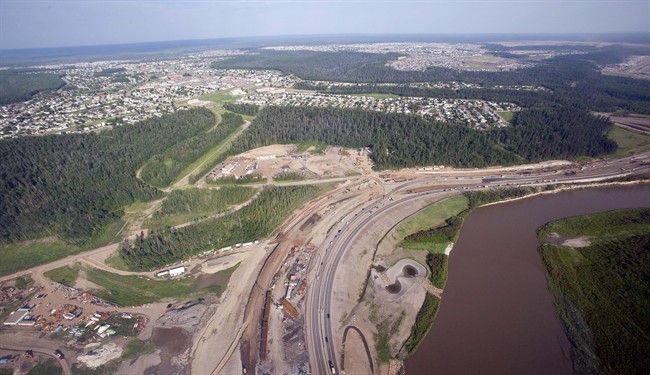EDMONTON – Recent research predicts restrictions on energy companies withdrawing water from the Athabasca River are a preview of what’s to come under climate change.

Low summer water levels by mid-century could be costing the oilsands industry billions of dollars in lost production, said Simon Donner, a professor of geography at the University of British Columbia and co-author of a paper published in Climate Change.
“Climate change is going to affect the river so much it’ll actually affect how much the industry can withdraw. This summer is basically a preview of the future.”
Earlier this week, Alberta’s energy regulator suspended a total of 73 temporary industry licences to take water from the Athabasca and Peace rivers because of low flows. Alberta Environment reports that water flows at the Athabasca station are about 43 per cent below average for this time of year.
READ MORE: Alberta Energy Regulator restricts river water use by oil sector, cites drought
Get used to it, said Donner.
Using mathematical models, he and co-author Doris Leong found that while overall precipitation in the Athabasca basin is likely to increase under climate change, the bulk of that flow will come earlier and earlier in the year.
Spring runoff is expected to begin up to a month earlier by 2050.
- Invasive strep: ‘Don’t wait’ to seek care, N.S. woman warns on long road to recovery
- Ontario First Nation declares state of emergency amid skyrocketing benzene levels
- T. Rex an intelligent tool-user and culture-builder? Not so fast, says new U of A research
- Do Canadians have an appetite for electric vehicles? Experts are divided
More precipitation in the area is already falling as rain, even in the winter. That shrinks the huge reservoir of water stored up as snow, reducing the amount released gradually over the summer.
“Snow is like this reservoir that slowly melts as you go spring into summer,” Donner said. “If more of that is falling as rain, it kind of flattens it out so that the peak happens earlier and it’s not as high.
“When you get to the summer, you end up with pretty low flows.”
The researchers found that by mid-century — well within the expected lifespan of most oilsands developments — low water levels leading to withdrawal disruptions will increase by up to 40 per cent.
Those flow disruptions will translate into a 22 per cent increase in interruptions to oilsands operations, equivalent to more than two years of oil production per decade, they say.
“In some cases … we’re talking up to two months or more per year in which the regulators would do what they did (this week) — no more water.”
The findings assume that the provincial government will maintain and enforce current policy on water use from the river.
“What we’re really talking about here is a tradeoff between industrial water demand and natural water needs,” said Donner.
Industry is taking steps to reduce its dependence on the Athabasca. Some companies remove water from the river and store it on site for when flows are low. Imperial Oil’s Kearl facility stores enough water to cover three months, said spokesman Pius Rolheiser.
Environmental groups have advocated for water storage to be made mandatory for any new oilsands projects.
Other companies have reduced their withdrawals by being more efficient and recycling water they do withdraw. Suncor’s withdrawals have declined by about 57 per cent since 2007 despite more than tripling production, said spokeswoman Erin Rees.
Such efforts do add costs in an industry already challenged by low prices for its product.
Donner said it’s an example of how industry will increasingly be forced to take climate change into account.
“It really just points to how long-term planning for the industry cannot ignore that the climate’s changing.”

Comments